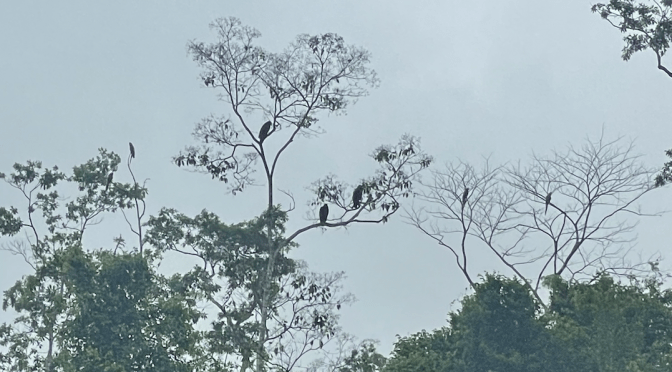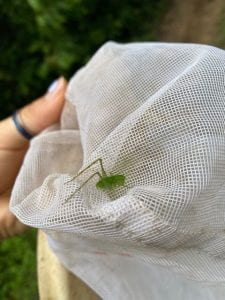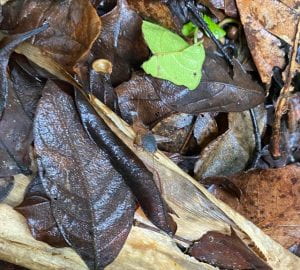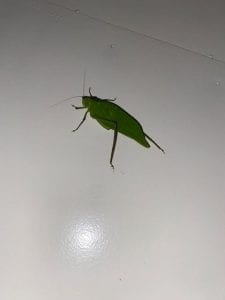Hi Blog,
To be honest, I was quite skeptical if I would be able to wake up at 4:30 AM to leave for the bird tower to watch the sunset, but surprisingly I did wake up. At 5 AM, Ian, Lily, Sadhana, Sam, Elise, Steve, and I started our hike to the bird tower. The hike there this morning for some reason was much more difficult than last night. While walking up the steep hills, I almost thought that I would not make it up there. But still I persevered and made it to the tower.
During our hike to the tower, we actually saw a Red Brocket deer dashing across the trail! It happened super fast, so I wasn’t able to get a picture, but it was still super cool to see another mammal, especially on our last day in the forest!
Once we went up the tower once more, all of our sufferings were worth it and I immediately forgot about the ache in my legs. The way the bird tower and its ladders shake with wind scared me a little bit because of my subtle fear of heights, but I trust its constructors and architects. We all sat down with our legs hanging off the tower and enjoyed the sunset and the peaceful chirping of the birds and the refreshing breeze of the winds. We stayed up there for about 3minutes, until my alarm that I had set up for 6:30 AM (in case I decided to not go to the bird tower) started going off.
Morning bird tower hike!
After we descended, we had delicious breakfast made by our lovely cook Angie. We then began our Taxon ID and topic lecture presentations before lunch. I presented my rainforest taxon briefing presentation, which was about rainforest mammals. Since we would be having a busy day tomorrow, we decided to combine the presentation schedule for tomorrow and today. After lunch, we finished the rainforest topic lecture (Elise’s amazing tropical medicine/disease presentation), and also began our coral reef lectures (hard corals, sponges, evolution of corals).
We then, after a short break, went on a hike to collect our camera traps to analyze. The results were very very exciting — we actually got 3 pumas on camera!!! The pumas all appeared to be roaming (maybe to hunt or maybe to simply frolick) in close proximity to the camera traps, and the disturbed roads, rather than undisturbed roads, appeared to have the highest prevalence of these big cats.
My camera trap (located in the undisturbed area off of San Pastoral road) didn’t have as exciting results, as it mainly captured me testing out the camera, taking it down, and putting it in my backpack. But still, it was still so fascinating to see all of the animals caught in other classmates’ footage. For example, we got a couple of turkeys and tayras and birds.

During the short break, since we are leaving Las Cuevas tomorrow morning, I pre-packed my items to relieve the stress of packing. I somehow lost my detergent bottle, but I still have laundry soap, so hopefully that will suffice,
After this, we went ahead and had our bonfire. It was really relaxing (despite the countless moths and bugs that kept running into my face) and a cute bonding moment for all of the tropical field biology-mates.
I’m sad to leave the rainforest, but I’m so excited to see the ATM cave, Belize Zoo, and our upcoming week at Glover’s Reef. Well then, I will see y’all tomorrow!
Goodbye Rainforest, but Not the Cockroaches!



Today was our last day in Las Cuevas! We started the day by collecting our camera traps. It took wayyyy quicker than it did in the morning. We’re practically experts on the trails now. We then listened to a variety of presentations about both parasites and infectious diseases in the forest and about the reef which is our next stop!
In the afternoon we all took a brief rat and studied outside together while we had WiFi. After dinner was when we got to see the images our camera traps had taken! There were a lot of candids of people on the cameras but we managed to see some amazing wildlife. We saw three pumas, several turkeys, and a few birds on the cameras! We were all super excited about the pumas as we all really wanted to see a big cat in the jungle, and our wishes came true! We ended the day with a special campfire in the middle of the jungle.
Dr. Solomon also had caught a bioluminescent click beetle and showed the class. These beetles are especially cool because not only do they glow through friction on their wings but they use friction to create a loud snapping sound when touched to scare and startle predators.
Day 3: Adventures Deploying Camera Traps!
“GOBBLE GOBBLE” That’s how day 3 started at about 4 am when I got woken up by a LOUD turkey under our building. I quickly learned just how active a rainforest can be before the sun even comes up.
Today we were tasked with coming up with a research question to ask about camera traps. Camera traps are motion sensitive cameras set up outside that take pictures of any movement (animals) in their range. We wanted to know how species richness of vertebrate animals varies on human constructed paths versus pure jungle areas. Our day was spent hiking along paths setting up cameras on the trail and then bushwhacking to get to a spot in the forest that was further off the trail.
Planning our camera trap locations
Flagging our camera trap 🙂
While we were on the trails with the intention of setting up the camera traps, we saw many cool unexpected things too. We saw a large cat footprint (jaguar or puma), some huge leaf cutter ant mounds, and multiple reptiles. I saw a pink-throated lichen anole, a silky anole, a rose bellied lizard , a neotropical green anole high in a tree, and the coolest part of today: a snake! While I did not get a great look at this snake as it quickly slithered away from the trail when we rounded a corner, I still observed some identifying features. It was about 4 feet long with a slender monochromatic brownish grey back and reddish belly. The scales were flat on its back and it slithered into grasses on the side of the trail. This all leads me to believe it was a racer of some sort, though I will never know for sure.
Rose bellied lizard
Silky anole
All in all, today had some really cool jungle sightings, and though it is HOT, I am loving the sticky rainforest.
See yall later!
Claire C
Trapping a Jaguar!!! (On camera, hopefully) (Day 10)
Hi all, it’s Faith with Day 10 updates from the 2022 Belize trip!!!
Today we woke up extra early (mostly on accident) to birdwatch from Las Cuevas Deck! We didn’t see any macaws, but we saw two- four toucans flying across the sky. They were gorgeous!
Then we went to plan out next research project. For our question, we chose “which area (trails, jungle, roads) will each animal group (large predators, small predators, large prey, small prey) use the most measured by relative abundance?” Our hypothesis was that big cats would be the dominant animals using paths and roads whereas small prey and mammals would stay under forest cover. We planned on using trap-cameras to get photos of animals as they cross the trails. By the way, while we were planning, we saw 4 scarlet macaws flying around!
Then we set off to se tho the cameras. Our first trip out we ran into our first of three white lipped turtles (Kinosternon leucostomum). This one was easy to identify because of its white lip, it looked just like one of the ones on my taxa sheet, and we found it swimming in a muddy puddle after the morning rains. After we saw the turtle, I set up my first camera on the “shortcut path” back to Las Cuevas. Because I went first, I was deemed the “camera soldier” and had to fix/ mess with lots of peoples cameras.
We did so much in this hike: set up cameras, use gps markers, walk through the jungle, eat termites, climb a bird tower, trip on Mayan stairs, see huge cave spiders, the list is endless.
I didn’t see my taxa again until after a light evening rain, and they were two mud turtles swimming around in mud puddles. I’m finding that these turtles vary greatly in shell appearance and patterning. The last two turtles lacked the classic white lip coloring, which caused me to misidentify them at first. However, their “bridge shell pattern” between the carapace and bottom shell indicated their true species. Plus, they were found in the same environment as the other white lipped mud turtle!
I’m hoping to see other types of mud turtles, like the Tabasco turtle. The wet season is proving to be good for turtle hunting but bad for reptiles and snakes. I’ll let you know what we see next!
Til’ Tomorrow!
QOTD:
“ if you leave me I’m signing up for an online orphanage”


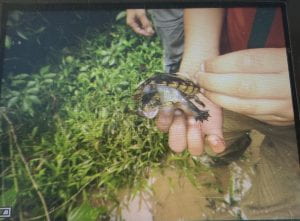

Rubber boots>hiking boots
Today was mostly one big recon mission to gather all the pitfall traps and camera traps we had set along the trails near Las Cuevas. We left at about 9 to gather all the pitfall traps, which involved cutting the wire we had used to strap the vial on the the tree, somehow unsticking the tubes from the ground, and of course, gathering all the flagging tape. This was a relatively short mission, especially compared to setting them up yesterday.
We got back to the research station, and began to collect our results and analyze our data. We didn’t finish the poster, so I’ll briefly explain what we found. Overall, we saw that there were more arthropods in the ground pitfall traps, and more arthropods in the the pee traps than in the water traps. This suggests that there are more arthropods on the ground than in the canopy, but that they are more attracted to nutrients.

We then left for the camera recon mission, which was also a shorter excursion than the one to set them up. We still have yet to look at the footage from them, but I’d image a lot of it will be pictures of us trying to set up and take down the cameras. Also, I don’t think I’ve mentioned this, but rubber boots are actually great for hiking!
I unfortunately did not see very many orthoptera today. I saw several small crickets, but they were too speedy for me to get a picture. One of them was really tiny, no more than 5 mm long. It was sitting on the dinning table, but it hopped away before I could invite it to stay and eat lunch with me.
I’m not sure how the next few days will look, but I will try to keep everyone updated!
-Elena
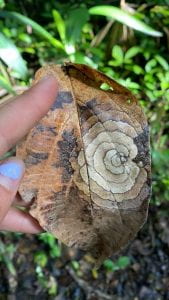
Fungi-full Day! (17/06/22)
We woke up to the sound of howler monkeys and a ton of birds. I wasn’t planning on doing the 5:30 morning birding but I apparently had no choice since the birds were so loud. They have turkeys here! I had no idea, and the turkeys here are so much prettier than the turkeys at home, they have lots of cool colors. We also saw some vultures and Scarlet Macaws! There are so many birds in the Chiquibul, I had no idea!
After breakfast we started our question using the camera traps and decided we want to see what functional groups of animals are using which parts of the forest splitting up by trails, roads, and just the jungle. After deciding everything we went out into the jungle for the first time hiking! It was sprinkling when we left and it continued to rain on and off the whole day. Right away we saw a ton of lichen on trees, all crustose so far, and plenty of mushrooms! Unfortunately a lot of them weren’t on my ID card, and I’ve been told that the fungi here isn’t well recorded or published so it’s hard to find comprehensive information on everything we could see. Most of the mushrooms were tan and brown, relatively close to the ground and maybe a couple inches across, with a pretty flat top. The smaller mushrooms were more bell shaped and much smaller, less than an inch but had longer stalks. I did manage to identify some turkey tail mushrooms on logs since they’re shelf-like, and easy to tell apart from the shape and the stripes (which look like a turkey tail), and even some puffball mushrooms! The puffball mushrooms were super cool, they had already released their spores, and were covered in mud from the rain but still had a little puff left in them if you bumped them a little. I’ve seen those mushrooms all over tiktok as food or just a cool thing to find in the forest so it was so cool to see one in real life!
We also saw some slimes and possible jellies, none of which were the ones I had put on my sheet specifically but hopefully with the pictures I took I can try to identify them eventually. The problem is it’s hard to get a good look at some of them since the fungi are off trail oftentimes, or under logs (where snakes like to hang out) or near ant nests, or are just in awkward positions and I don’t want to touch mushrooms unless I know what they are. At least eating mushrooms isn’t an issue, I can’t stand the texture of mushrooms, so I can admire them from a distance and not worry about getting poisoned by some random mushrooms out in the woods. I do have a lot more respect for anyone who really knows their fungi and can actually identify species and safe versus poisonous types, especially since so many mushrooms have look alikes! I’m hoping tomorrow out in the woods we’ll find something new, since today the mushrooms got pretty repetitive, I have a lot of really cool colorful mushrooms on my wish list of things to see here, so hopefully we’ll have some luck tomorrow finding more!
We finished up the day with some lectures, unfortunately without lights we couldn’t actually write in our notebooks, however we did manage to come up with some good field biology DIY solutions!
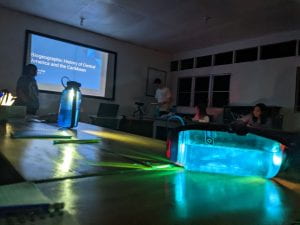
Bug madness
I know I said yesterday was the first day in the rain forest, but today was the actual first day in the rainforest!
We started out the day by figuring out how we were going to conduct research with the camera traps. We decided to look at the abundance of different types of mammals on different passageways, including the main road, the trails, and forest. Once we had our methods figured out and a plan for which path to take, we were on our way! We set six camera traps in the morning-all five road traps and one trail trap. We returned to the station for lunch, and then set out for the afternoon to walk another trail and set the other ten traps (four more trail traps, five forest traps, and one for-fun trap at a pond). We were out in the rain forest from 1:30 until 6:15, which was absolutely amazing. We got rained on a bit (which is always exciting for me because I’m from CA), and the forest was super lush and full of so much life.

We saw a lot of amazing things. I actually saw a bunch of orthoptera, which I wasn’t entirely expecting, since they’re so good at camouflage. I saw some tiny crickets in the grass, possibly a pygmy mole cricket, and a small green katydid on the branch of a tree.
I saw a group of black grasshoppers with red heads on the branch of a small tree as well. I thought it was odd that they were in a group, as grasshoppers and other orthoptera are usually solitary. I also saw a small-ish brown cricket that looked almost like the the jerusalem cricket.
The most amazing orthoptera sighting for me was at night during the post-dinner presentations! I got to see a huge leaf mimic katydid (shoutout Michael for grabbing it for me)-it was probably about 3 or so inches long! In order to grab katydids, you have to grab their wings and their femurs because their back legs are so strong, they can push against your hand and make you lose your grip. We also saw a smaller katydid, maybe two inches long (shoutout Rusty for catching it). Both were a vibrant green, and their wings really did look like leaves! Too bad they were in a classroom, so their camouflage didn’t work so well.
Overall the day was jam-packed with excitement. We saw a bunch of other really cool organisms, such as birds, beetles, cockroaches, and ants, as well as countless trees and epiphytes that we had only just read about in the text book. We got to try eating termites (which taste sort of like carrots!), and we climbed to the top of a bird watch tower to see the amazing view! We also saw a cave that had maya pottery and a wall in it, and a giant leaf cutter ant nest, that was probably about three or four feet in diameter.

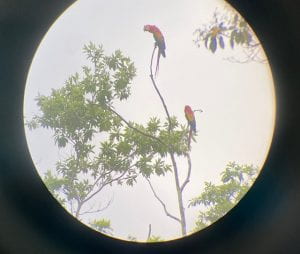
I can’t wait to see what tomorrow brings, since today the main focus was just setting the camera traps!
-Elena
A Spectickular Day
Today, May 16th 2019, I had an early morning with 5:00 early morning birding. There was eerie mist surrounding the clearing and it was almost ominous to hear the jungle amongst suddenly come alive with bird calls. It started with the hoots of the Blue Breasted Mot Mots. The grey form of a Plumbious Kite flew into a tall tree and a pair of parrots flew overhead (flapping their wings rapidly and almost screaming) (this is completely normal and it looks like they’re panicking). Some Melodious Blackbirds and yellow breasted Social Flycatchers also made appearances. Perhaps the most surprising site was a Grey Fox slinking back into the forest at the edge of the clearing. The display that took the cake was the Plumbious Kite sweeping down from its perch to catch an insect and feed it to what I assume was its baby that was in a tree right in front of us.
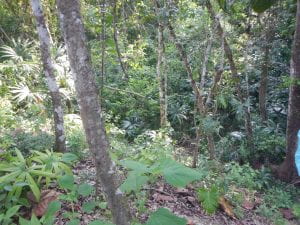
After, we had breakfast and an orientation and we started our experiment. In short, we’re investigating if the presence of the research station impacts species richness and abundance at different distances from Las Cuevas using images from camera traps (movement sensitive cameras). First, we hiked up a 50-hectare plot, a rectangular plot (50 hectares in area), and after 45 or so minutes we placed our first camera trap. On the way, we saw so much life such as beetles and crickets. Excitingly, we saw a couple instances of mammal scat (feces) and a game trail (a trail created by a large animal running through the forest to find food). A good indicator of a game trail is snapped vegetation with a compressed path through the forest. On the way back along the trail to place some other camera traps we saw a troop of Central American Spider Monkeys dwelling amongst the canopy. They shook trees, a behavior used to intimidate, and used their prehensile tails and great climbing skills to follow us until we exited their territory.
We then hiked up a longer trail called Monkey Tail Trail to place more camera traps and saw many ants (some of which bit people) and attracted the attention of a multitude ticks.
With a long day of hiking behind us, we ate dinner and ended the day with presentations on epiphytes, arachnids, and an overview on life in the rainforest canopy.
Tomorrow we have a project to construct in the morning and may go on to explore a nearby cave which is exciting beyond belief.
Day 7: chant with me: ants! ants! ants!
Today’s general agenda: retrieve camera traps —> finish poster for project mutualism —> check out leafcutter ant colonies —> look at camera trap photos
Here’s a missed opportunity: Ant-Man should really be Ant-woman instead
Did you know that if you see an ant on the ground, you are most likely observing a female worker ant? These ants are infertile ants that do many important tasks to keep the colony up and running. Male ants only appear during mating season. Today was definitely another fruitful day in the ant department. In the early afternoon, we got to make a poster and present on our project focused on Azteca ants and their mutualistic relationship with Cecropia tree. We found that, on average, uncolonized trees have tougher leaves, meaning they are less likely to be eaten by herbivores. However, we definitely need more data to validate our results.
In the late afternoon, Dr. Solomon, the actual ant-expert, took us around the research station to compare leafcutter ant colonies of different ages. We were specifically looking at colonies of A. cephalotes. These colonies can have millions of individuals residing in them, and they can be seen as one of the earliest farmers.These ants collect leaves to grow fungus, and the fungus is then fed to ant larvae. When aggravated, these ants can use their sharp mandibles and actually chew through rubber boots. It was a surreal experience getting to observe what I have been researching in preparation for the trip.
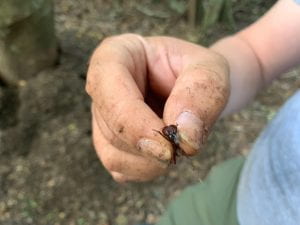
As our grand finale for the rainforest, we all sat in the classroom to look at the photos the camera traps took over the course of the five days we were in Las Cuevas. We were all on the edge of our seats because we just were not sure what to expect. I think we can all agree that the best picture that was taken was of a tapir walking on the path. On that note, I think we are all ready to further explore Belize and head to the coral reefs.
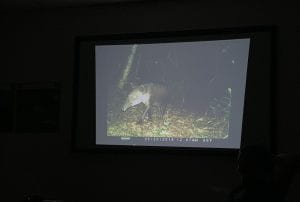

As a mid-trip reflection, I am already amazed by how much we have learnt in such short amount of time. Even though I was initially worried about having minimal internet access, I think the disconnection allowed us to be fully immersed in our environment. I
Brendan Wong
Las Cuevas, Belize
5/20/2019
Day 3: and they came out of nowhere!
Today’s agenda: Las Cuevas research station —> exploring trails and setting up camera trap —> Las Cuevas Research Station
Part of our trip objective is to conduct a research project around Las Cuevas Research Station. Our group came up with the plan to examine how the research station itself may serve as a disturbance for species diversity around Las Cuevas. To give some context, we are currently in a circular shaped clearing surrounded by the rainforest. We think that as we move farther away from the research station, we will see more diverse animals in numbers and species.
We are using this technique called camera trapping where we pick certain locations and set up a camera to take pictures of anything that moves in front of it. I am hopeful that we would be able to spot some big cats (jaguar or puma) because on our way to our first camera trap spot, we saw what appeared to be some recent paw print on the floor.

Speaking of travels, we hiked a total of 5 hours today, climbing up and down hills. With our field gear on, we were able to explore the rainforest in-depth. We saw spider monkeys, blue morpho butterflies, spiny orb weavers, Xaté fishtail palm, and so much more! In the ant department, we spotted army ants, Pseudomerymex ants, Dolichoderus ants, and fire ants. Somehow, twice today, I had ants all over me. One even bit me under my shirt. These ants are not so forgiving when you come across their nests. Oh, and did I mention that I also ate a termite, but we’ll just have to save that story for another time.
At the end of the day, after seeing almost something from each taxonomic group that each of us had, we ended up finding ourselves with either a few ticks or maybe 100 of them! They came out of nowhere! Turns out, ticks are hard to kill. To effectively kill them, you have to use your nail on one finger and press it against your other finger so it effectively cuts ticks in half.
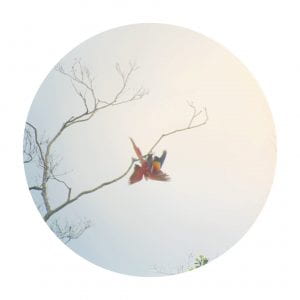
Brendan Wong
Las Cuevas, Belize
5/16/2019







